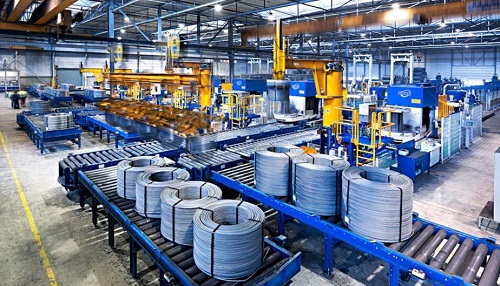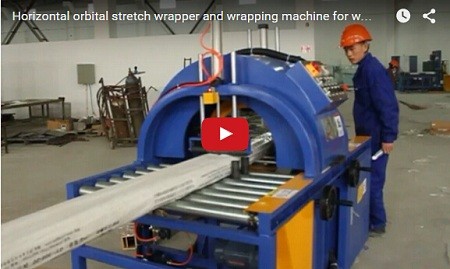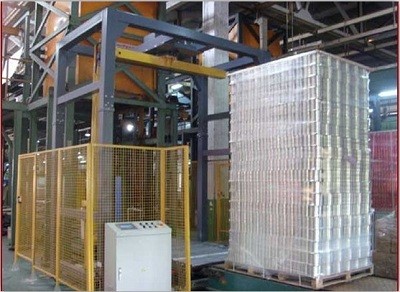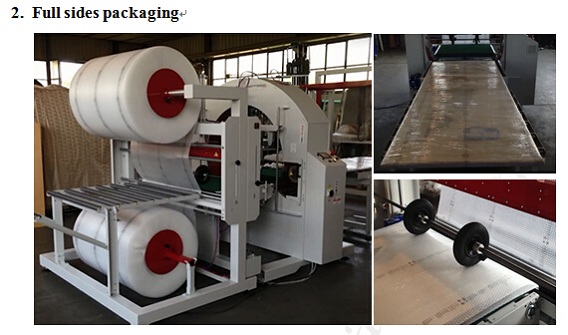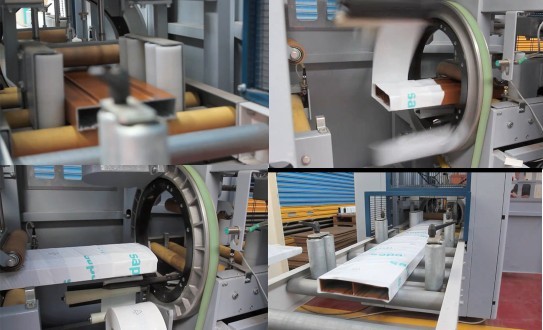Streamlining Operations: A Guide to Automatic Pipe and Hose Coiling and Strapping Machines
Managing long lengths of industrial pipe and hose efficiently and safely presents a significant challenge in many manufacturing and fabrication environments. Manual coiling and securing methods are often time-consuming, labor-intensive, and can lead to inconsistent results or even worker strain. Automatic pipe and hose coiler and strapping machines offer a robust solution, automating these critical processes to enhance productivity, improve product handling, and ensure workplace safety.
This guide explores the functionality, benefits, and key considerations when evaluating these automated systems for your operation.
What is an Automatic Pipe and Hose Coiler and Strapping Machine?
An automatic pipe and hose coiler and strapping machine is specialized industrial equipment designed to autonomously wind flexible pipes or hoses into uniform coils and then securely fasten them with strapping material (typically PP or PET). This integrated system streamlines the end-of-line packaging process for products like corrugated pipes, hydraulic hoses, garden hoses, PE pipes, and more.
The machine typically integrates several key components:
- Infeed System: Guides the pipe or hose smoothly into the machine.
- Coiling Unit: Employs a winding mechanism (often a rotating drum or mandrel) to form the material into a neat, predetermined coil size. Features often include adjustable inner diameter (ID), outer diameter (OD), and coil width settings.
- Cutting Mechanism: Automatically cuts the pipe or hose to the desired length once the coil is formed.
- Transfer System: Moves the completed coil from the coiling station to the strapping station.
- Strapping Unit: Applies one or more straps around the coil circumference at pre-set positions, tensioning, sealing, and cutting the strap automatically.
- Ejection System: Discharges the finished, strapped coil, often onto a conveyor or holding area.
- Control System: Typically a PLC (Programmable Logic Controller) with an HMI (Human-Machine Interface) for setting parameters, monitoring operation, and diagnostics.
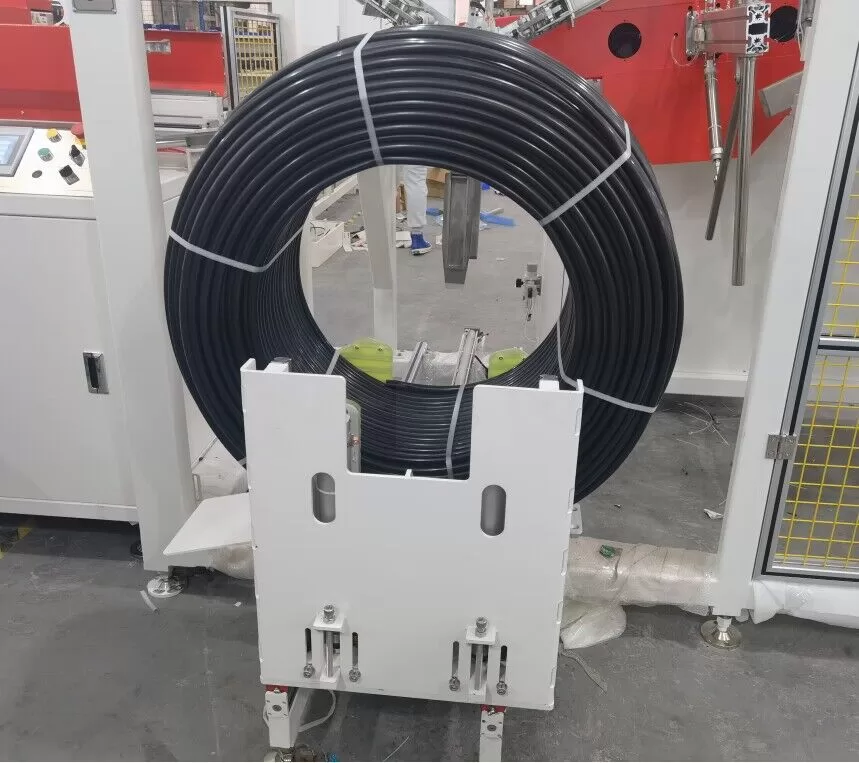
automatic pipe coiling machine, automatic hose coiling machine3 How Does the Automation Process Work?
While specific machine designs vary, a typical operational sequence involves:
- Feeding: The pipe or hose is fed into the machine, often directly from an extrusion line or payoff stand.
- Length Measurement: Sensors or encoders accurately measure the length of the material being fed.
- Coiling: The coiling unit winds the material until the pre-set length is reached, forming a compact coil.
- Cutting: The integrated cutter cleanly severs the pipe or hose.
- Coil Transfer: The finished coil is automatically moved to the strapping position.
- Strapping: The strapping head(s) apply, tension, seal, and cut the required number of straps around the coil.
- Ejection: The securely strapped coil is ejected from the machine, ready for storage or shipment.
Key Benefits for Fabricators and Manufacturers
Integrating an automatic coiler and strapper offers significant advantages:
- Enhanced Productivity and Throughput: Automating the coiling and strapping process dramatically increases output compared to manual methods. This reduces bottlenecks and frees up labor for other value-added tasks, directly impacting profitability.
- Improved Product Quality and Consistency: Machine-controlled coiling ensures uniform coil dimensions and tightness, while automated strapping provides consistent tension and securement. This reduces the risk of coil collapse, tangling, or damage during subsequent handling, storage, and transportation, leading to fewer product defects and returns.
- Increased Workplace Safety: Automating the repetitive and often physically demanding tasks of manual coiling and strapping significantly reduces the risk of musculoskeletal injuries and strains for workers. This contributes to a safer work environment and potentially lower workers' compensation costs.
- Optimized Material Handling and Storage: Neatly coiled and securely strapped products are easier and safer to handle, stack, palletize, and store. This optimizes warehouse space and streamlines logistics operations.
- Reduced Labor Costs: By minimizing the need for manual labor in the coiling and strapping process, businesses can achieve substantial long-term savings on labor costs.

automatic pipe coiling machine, automatic hose coiling machine2 Selecting the Right Coiling and Strapping System
Choosing the appropriate machine requires careful consideration of your specific needs:
- Product Specifications: What are the diameter ranges, materials (rigidity/flexibility), and types of pipes/hoses you handle?
- Coil Dimensions: What are the required inner diameter (ID), outer diameter (OD), and width of the finished coils? Does the machine offer sufficient adjustability?
- Throughput Requirements: What production speed (coils per hour) is necessary to keep pace with your manufacturing line?
- Strapping Needs: How many straps per coil are required? What type of strap material (PP, PET) is suitable?
- Level of Automation: Do you need a standalone machine or one fully integrated into an existing production line?
- Space and Layout: Ensure sufficient floor space and compatibility with your existing facility layout.
- Budget and ROI: Evaluate the initial investment against the projected savings in labor, improved efficiency, and reduced product damage.
Conclusion
Automatic pipe and hose coiling and strapping machines represent a valuable investment for manufacturers and fabricators dealing with long lengths of flexible materials. By automating these crucial end-of-line processes, businesses can achieve significant improvements in productivity, product consistency, workplace safety, and overall operational efficiency. Carefully evaluating your specific requirements against the capabilities of available systems will ensure you select a solution that delivers tangible benefits and a strong return on investment for years to come.
For more information, contact: info@fhopepack.com
- How to operating Pipe packaging line Film Delivery System Power Roller-Stretch Additionally ...
- upender Manufacture drawings, manufacture supervision report and record, inspection and test report before delivery, running test report and unpack report, etc. Other standards approbated by both Seller and Buyer.4.3 Content of inspection and acceptance

- Top supplier for Cable wrapping machine production line and sharing products information for automatic packaging. The automatic packing line will be designed per different ..

- the technical data of Tyre wrapping machine offering individual content articles to a conveyor program;

- the technical data of Pipe coil wrapping machine The period of guarantee has a term of 12 months since the confirmation date of eligibility of inspection and acceptance. It will be to Seller’s care to maintain the equipment free of charge during the guarantee period. But the guarantee term excludes: Equipment damage caused by force majeure Any changes on design without Seller’s approval Equipment damage not to Seller’s responsibility Roll Diameter
- the feacture of the PPR/PVC Pipe bundling machine To test and confirm the integrality of functions and working procedures in load running situation. To test and confirm the system reliability in load running situation. To exam and confirm that the equipment can realize values guaranteed in Inspection and Exam Stipulations. As destructive as earthquakes are, there are ways to minimize preventing some of the damage they are able to cause. As an example, better engineering, design, and building codes have dramatically reduced the potential risk of damage from earthquakes. Likewise, better stretch wrapping is able to reduce risk of damage to your pallets from mini earthquakes during shipping.

- How to operating Coil packaging machine The machine, equipped with the appropriate device, is self-cleaning and it is very low maintenance because of the simple construction. Vacuum bagging and film packaging and gas flush options result in the Bingo Bagger well suited for food service, Don??¥t be victimized by mini earthquakes. Minimize the risk of your loads being damaged from your outcomes of vibration enroute to your customers. It's not that hard and the benefits are enormous. ...

- the feacture of the tilter and upender an article supply for supplying individual articles;the packaging subsystem with regard to packaging person articles in to packs; Film Delivery System Power Roller-Stretch Additionally ... ...

